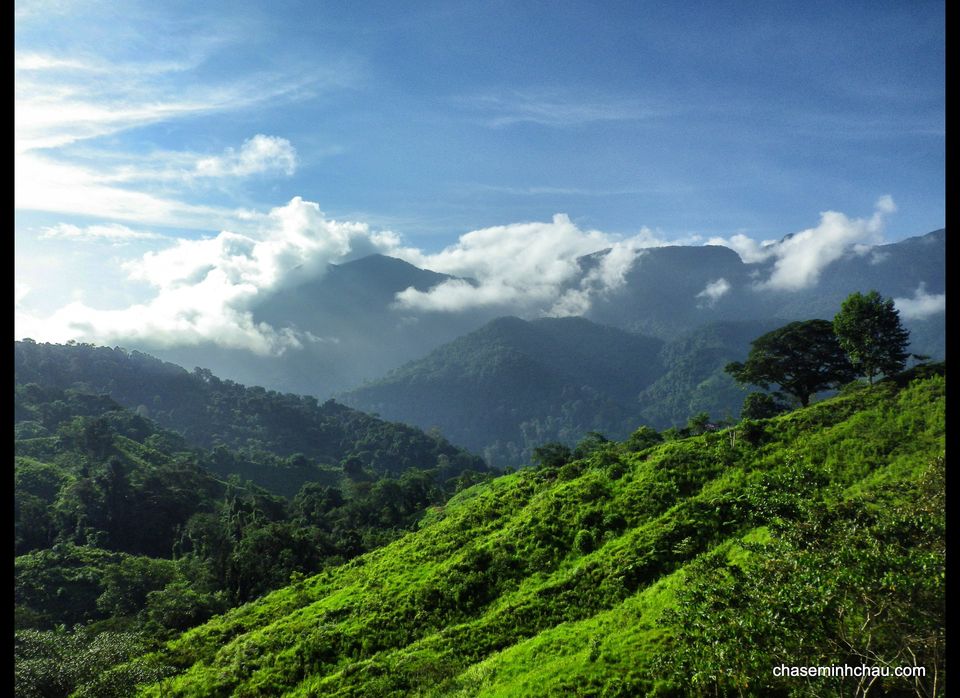Rain check Machu Picchu and challenge yourself this year with a trek to La Ciudad Perdida, The Lost City tucked inside the dense jungles of northern Colombia.
The combination of heat, humidity, and inclines will make the 4-6 day trek very uncomfortable, but rewarding. We started off in the small town of Mamey, where we fueled up on bread, ham, and cheese, because, little did we know at the time, we would need all the energy we could get. We kicked it off with an easy hour's walk. But, in the high humidity of the steamy Colombian jungle, even just standing there caused the body to sweat. Slowly, before the hard part started, my shirt was turning a shade darker as sweat spread into larger concentric circles. Unfortunately, whatever becomes wet in the jungle often stays that way.
Respite was always short lived, because as soon as we managed to catch our breath, it was time to march forward for more hours of ups and downs accompanied by an overpowering heat that never seemed to go away. Along the way we crossed the Buritaca river multiple times, but the river also served as our jungle oasis. If trekking through the jungle was like being baked in an oven, jumping into a Buritaca-fed natural swimming pool from the top of a boulder was a refreshing opposite.
In the remoteness of the Colombian jungle we were treated to sweeping views of thick foliage that were breathtaking, and also intimidating in their reminder of how far away and remote from civilization we were. Occasionally, we encountered the indigenous people, standing solemnly in their (formerly) white smocks as they let us pass by. When the sun set, we navigated around camp using headlamps, ate dinner by candlelight, and slept to the sounds of the night time jungle noises reverberating around us.
On the third day, excitement and suspense built up as we approached the first of 1,200 steps leading up to La Ciudad Perdida. Each step was covered in slippery moss, and as if to add an additional defense mechanism to the city, each step was narrow and appeared to had been made for feet much smaller or with much more elegance than ours.
It is an incredible feat that the city was constructed as well as it had been in the dense mountainside jungle swarming with mosquitoes and battered by endless rainstorms. In fact, one of the many names given to The Lost City translates into "green hell" because of the dangers of the jungle.
At the top most terrace, we bumped ways with several of the Colombian military men charged with guarding La Ciudad Perdida. Many smiled at us as they walked past us with guns in hand. We were the only other people there, giving us a wide view of the ruined city and letting our imagination run wild imagining the bustling city that once stood where we stood. The remoteness of where we were, with nothing but the sounds of the jungle around us, made it felt like we truly did discover The Lost City. We came upon two large stones, each of which had a map of the city and the region delicately carved upon its face. It was like looking at a treasure map, and it was up to us Goonies to find the rest of the hidden city.
Read more about my time on the trek here.
About La Ciudad Perdida
Formed over 600 years before the birth of Machu Picchu, La Ciudad Perdida ("The Lost City") is located in the dense jungles of Colombia's Sierra Nevada de Santa Marta. Better known as Teyuna by the indigenous people, the Lost City, given its large size relative to other towns that have been discovered, was likely once the center of regional political, social, and economic power. According to the Global Heritage Fund, Ciudad Perdida was one of more than 250 stone masonry towns that formed in the northern part of the Sierra Nevada between 200 AD to c.1650 AD. The ruined city covers an area greater than 80 acres (a football field is slightly larger than one acre), with some 200 plus structures that include terraces, plazas, canals, and much more. It's currently on the tentative list to be named a UNESCO World Heritage Site.
Abandoned during the Spanish conquest, the city was engulfed by the lush vegetation of the Colombian jungle. It was "discovered" in 1975 by looters in search of pre-Colombian artifacts, but has since been under preservation efforts by the Global Heritage Fund and the Colombian Institute of Anthropology and History.
